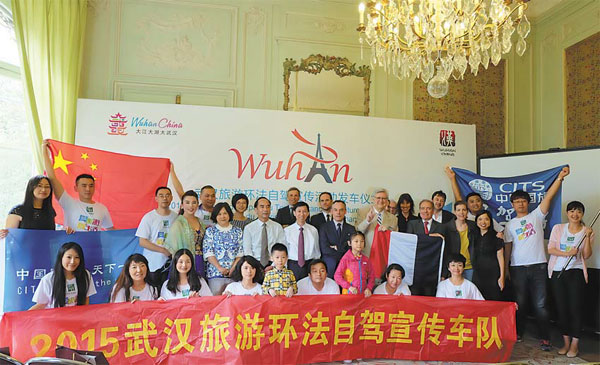Celebrating central China in France

Capital of Hubei province promotes its cultural heritage and ties to European nation with fun driving tour
A group of Wuhan residents flew to Paris on June 16 to begin a driving tour through 10 French cities that is ending on June 28.
An opening ceremony for the tour was held on June 18, the same day the Wuhan Tourism Promotion Center in Paris began promoting the Chinese city in the French capital.
| An opening ceremony is held in Paris earlier this month for a group of Wuhan residents before they embark on a driving tour through 10 cities in France. Photos provided to China Daily |
The tour, organized by the Wuhan tourism bureau and the French Consulate General in Wuhan, aims to illuminate both the cultural and tourism resources of the capital of Hubei province and to promote its international image and influence.
Wuhan has deep historical connections with France, dating back to 1964, when China and France established diplomatic relations. Since then, Wuhan has been a pilot city for cooperative projects between the two countries.
The city opened Central China's first direct flight to Paris and has China's largest learning base for the French language. It is also home to the largest Sino-French auto venture, Dongfeng Peugeot Citroen Automobile Co Ltd.
It is currently the top destination for direct investment from France.
Li Na, who became the first Chinese national to lift the French Open winner's trophy in 2011, was born in the Jiang'an district of Wuhan. The Chinese tennis legend likes to humorously promote her hometown by telling foreign media outlets that Wuhan is a small place with a population of just more than 10 million.
Wuhan is the largest city in Central China and is the transportation hub of the region, linking cities from north to south and east to west through air, rail, river and sea routes.
The city is divided into three parts by the Yangtze and Han rivers: Hankou, Wuchang and Hanyang, each with their own distinct character.
Hankou is the city's commercial and financial hub, Wuchang is famous for its cluster of universities and research centers and Hanyang is the city's production center. They are interconnected by bridges over the Yangtze River.
Wuhan also has a rich history and cultural heritage.
Panlong, which translates into lying dragon city, was the first historical relic from the Shang Dynasty (16th-11th century BC) to be discovered in the Yangtze River basin. Situated in the northern suburb of Wuhan, the ancient city has a history of more than 3,500 years.
Other cultural heritage items and tourist spots include the Yellow Crane Tower and Guqin Tai, which literally means the table for placing a guqin, a Chinese traditional stringed instrument.
Guqin Tai is the name of a site in an old Chinese legend, where Chinese guqin master Yu Boya played the instrument with his friend Zhong Zhiqi, a woodcutter. Zhong was the only one who understood Yu's music. After Zhong died, Yu broke his guqin and never played it again.
Wuhan has 80 institutes of higher learning and about 1.2 million students.
The city is also an important center for advanced manufacturing and high-tech industries in China. Its Optics Valley is famous for the design and production of high-end fiber optic products, laser technology and other high-tech devices.
(China Daily European Weekly 06/26/2015 page29)
Today's Top News
- Japan tempting fate if it interferes in the situation of Taiwan Strait
- Stable trade ties benefit China, US
- Experts advocate increasing scope of BRI to include soft power sectors
- New engine powers cargo drone expansion
- China to boost green industry cooperation
- Manufacturing PMI rises in November































